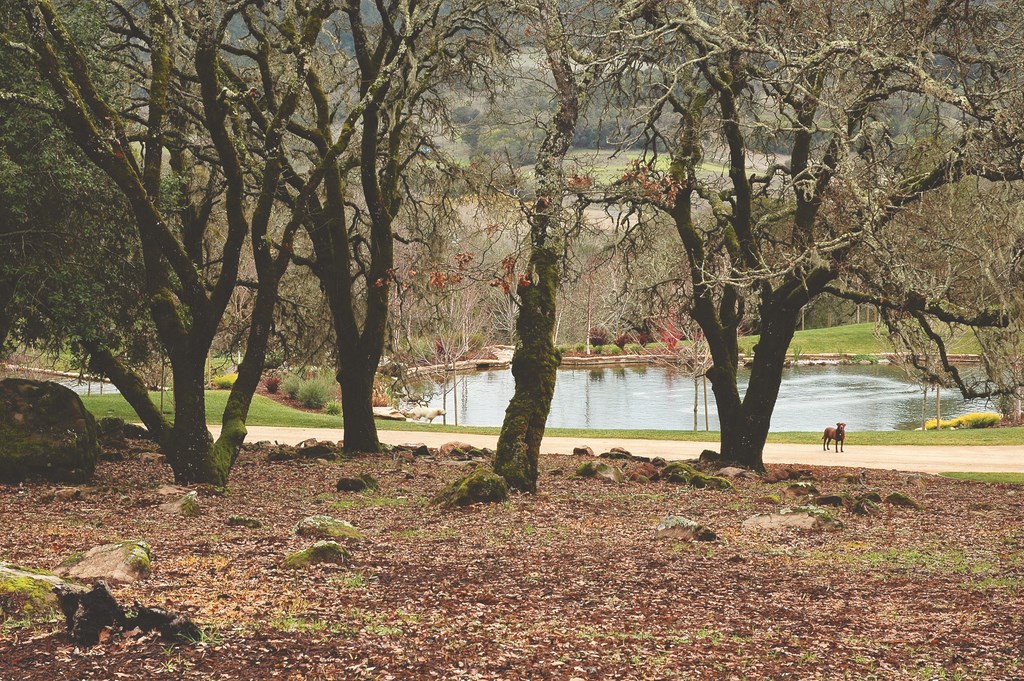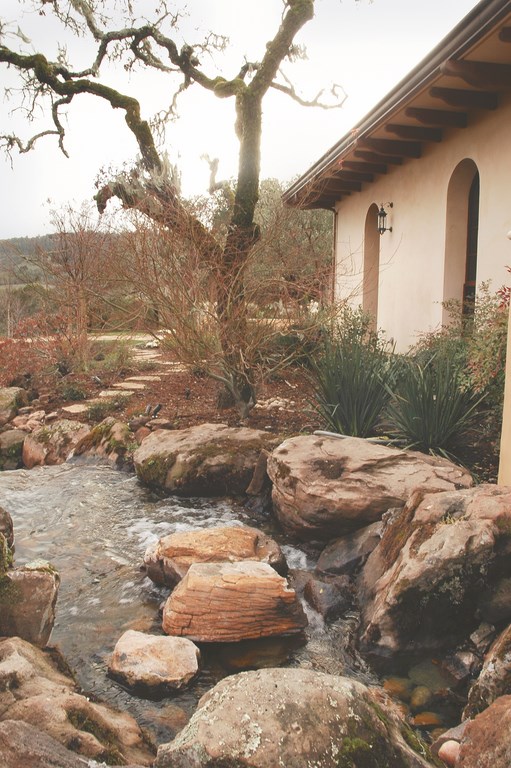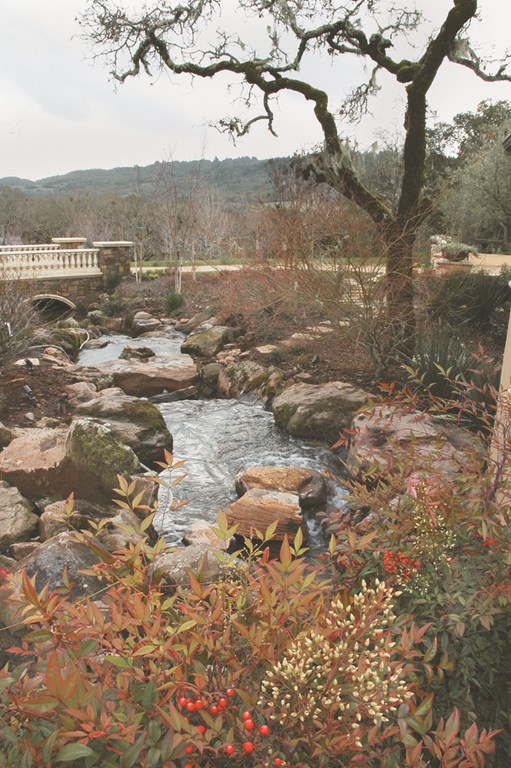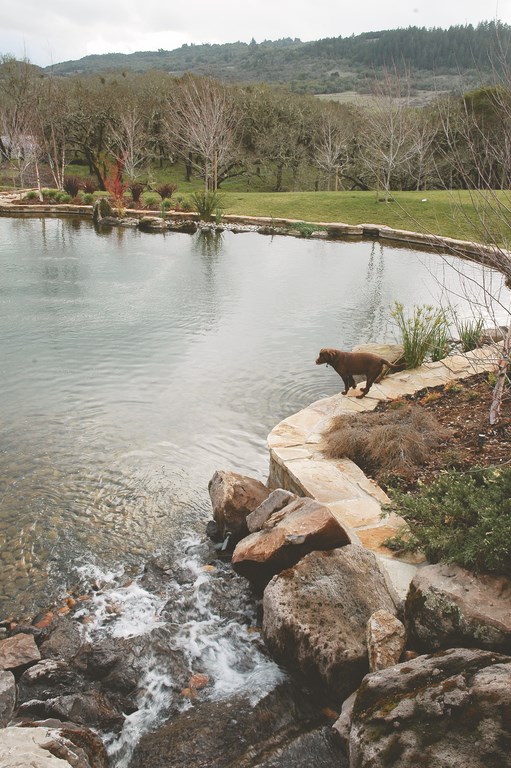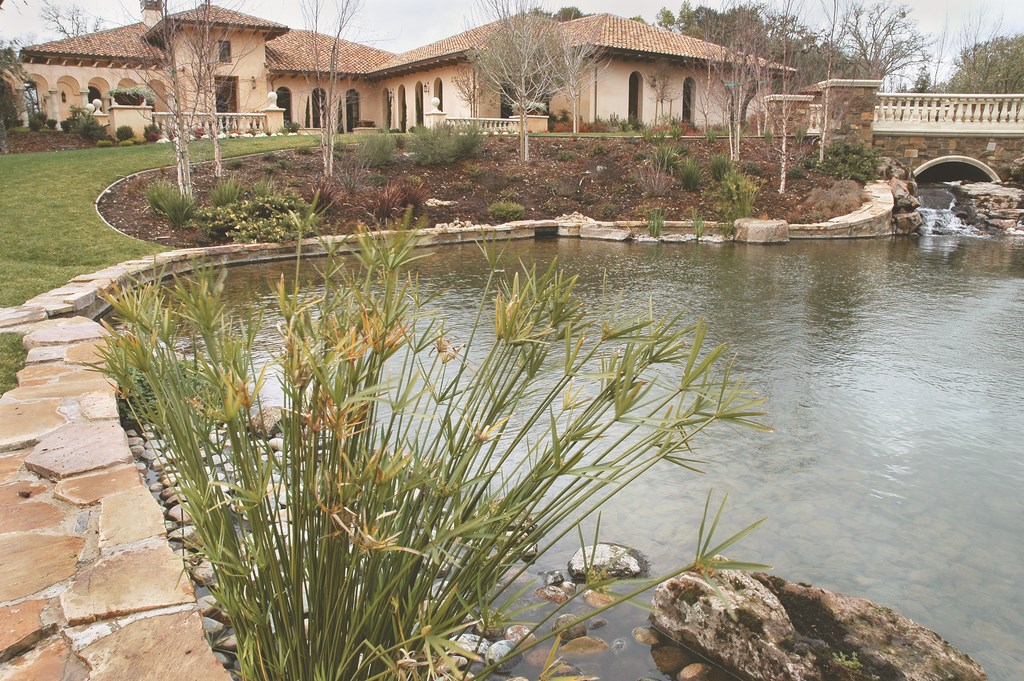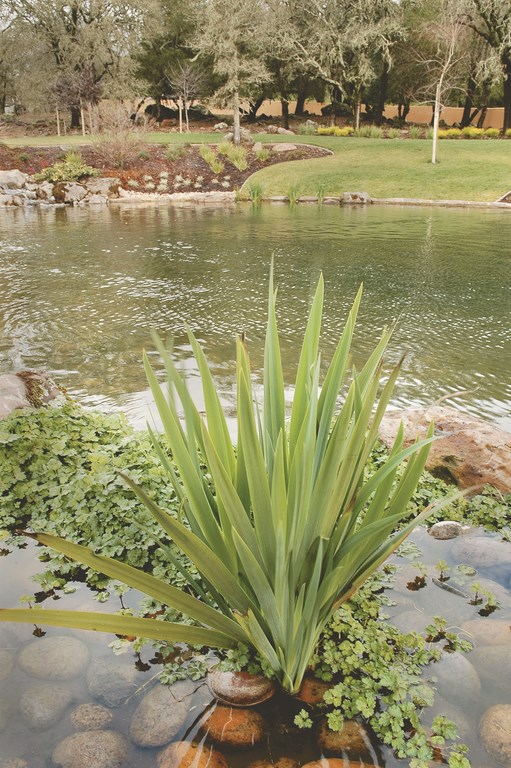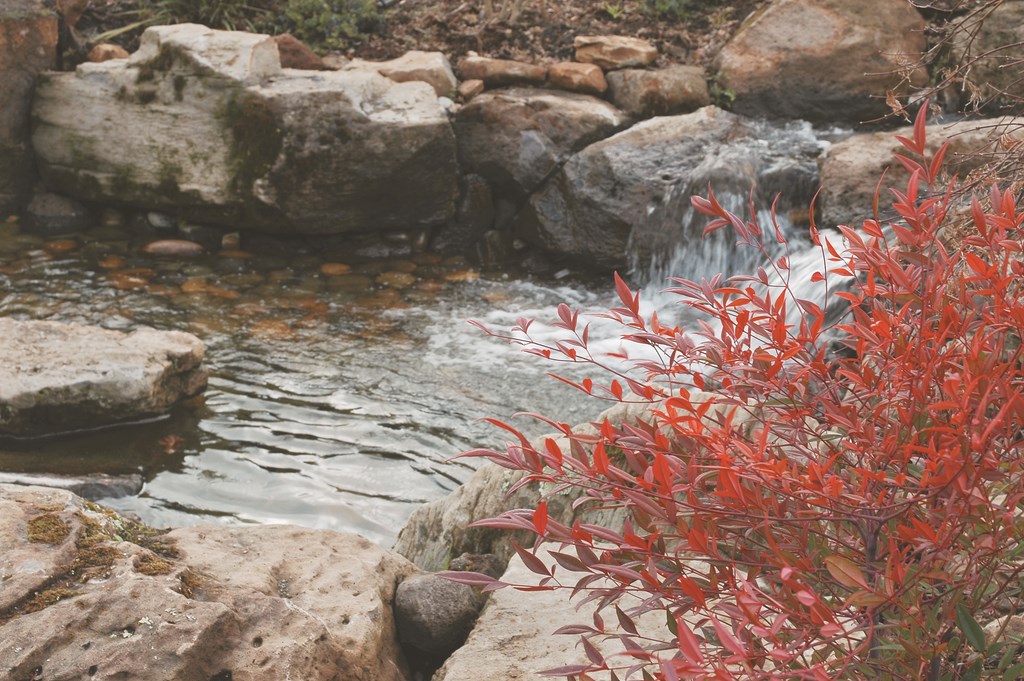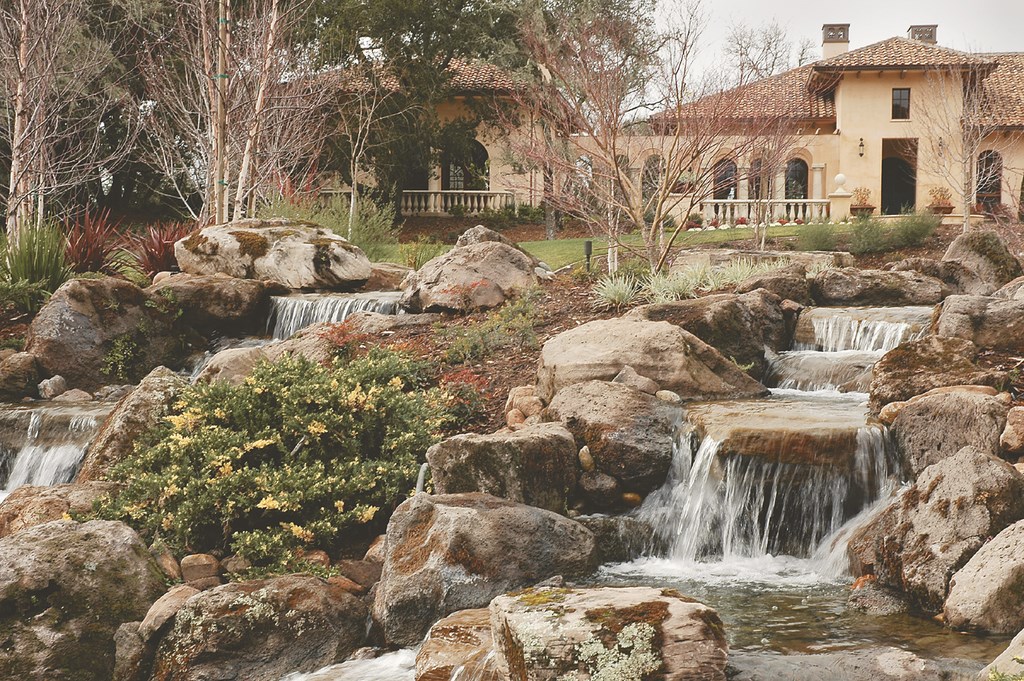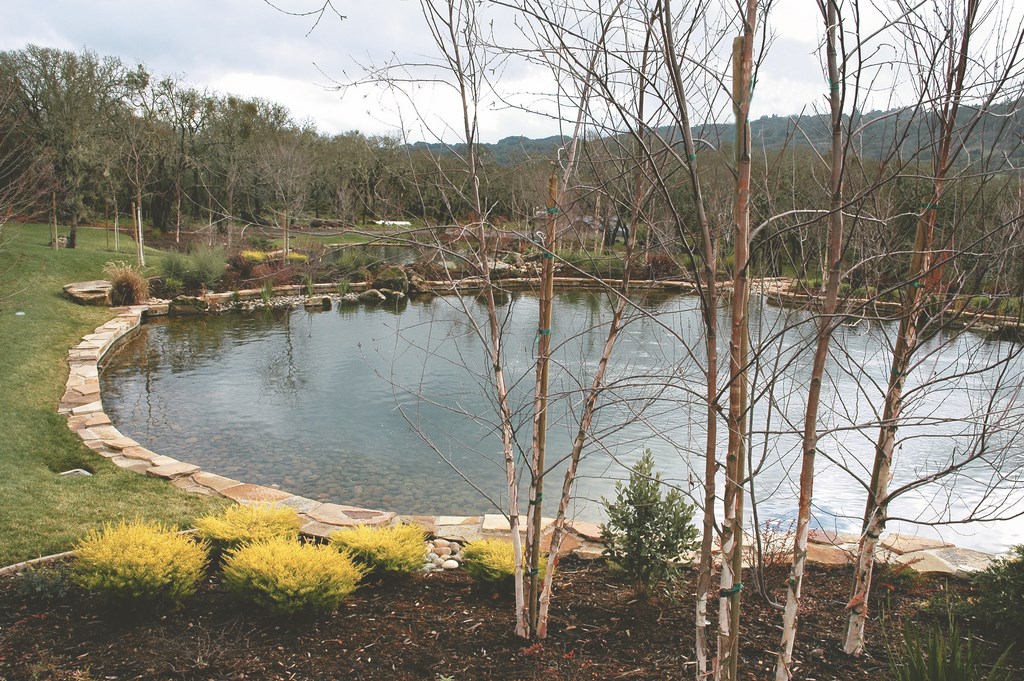A Crystal-Clear Mandate
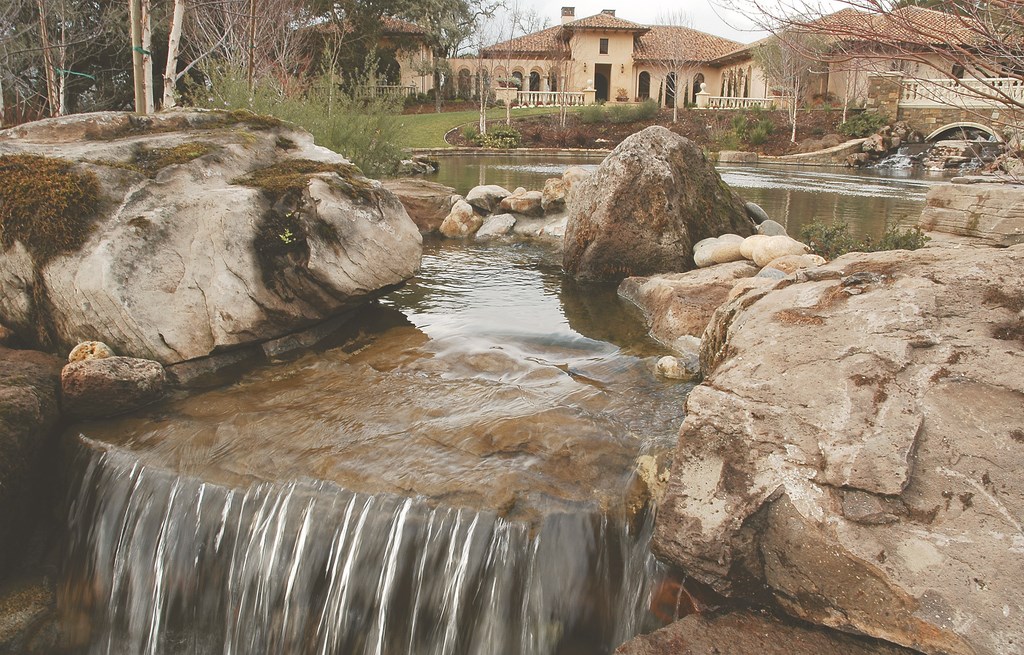
Our projects generally take two forms.
On the one hand, we’re called upon to “heal” ailing bodies of water that have been set up with inadequate or improperly functioning circulation and filtration systems. Although other people’s mistakes mean good business for us, I won’t say that we ever look forward to seeing potentially beautiful ponds or lakes cursed by unappealing or even unhealthy water conditions.
On the other hand, we often have the opportunity to join a project at the design phase and handle the installation as well, applying what we know about water quality from the first conceptualization of the watershape. That’s always a welcome prospect: Not only is it exciting to build things from the ground up, but it also gives us the capacity to ensure beautiful water and a satisfied client.
The project to be covered here is of the latter category: Our involvement began when we received a call from the property’s developer, an upscale builder in California’s beautiful Sonoma County. It was a unique situation in which two large ponds were to be located on a 100-acre site that was to host two grand estates.
The main requirement: The developer wanted the ponds to have extremely high water quality without the use of any chemicals.
SITE LINES
From the start, we at Aquatic Environments (Alamo, Calif.) worked hand in glove with a terrific landscape architect, Peter Wurtz of Landesign Group (Sebastopol, Calif.) He’d shown the owners photographs of beautiful ponds he’d seen in Arizona, a process that had given them a good idea of what they wanted.
We put our reputation on the line, declaring that we could deliver systems that would meet (or exceed) both the water-quality and aesthetic goals defined for the project and went to work. The basic idea was that the two ponds were to operate separately but would appear as though they were part of a single system lain between the two homes on the property.
| As you enter the property, you’re treated to a view of the ponds through the oak trees. In all, the water covers a surface area of an acre and a quarter between two estate homes. (All photos by Michael Weiser, Michael Weiser Photography, San Jose, Calif.) |
The site featured rolling hills, stands of live oak and a landscape strewn with boulders and beautifully weathered fieldstone. We knew immediately that the rock material would simplify the process of blending the ponds into their natural surroundings; we also knew that we wouldn’t need to go far to get all the stone we needed.
The basic design also called for use of a tremendous amount of plant material right down to the water’s edge – easy to do, but also a major potential challenge to the water-clarity goal.
The first step in the installation phase involved creation of a large earthen dam. The ponds were to be located on a sloped area, so the downhill side of the slope had to be built up both to stabilize the slope and to provide a flat area for the watershapes. The nature of this contouring led us to use a vinyl liner rather than a clay liner: We needed to prevent any water seepage that might compromise the dam.
| The stream feeding the upper pond has its headwaters in small stilling ponds adjacent to one of the homes. The water flows down under a bridge before falling through a short cascade and into the upper pond. |
Use of the vinyl liner had some other advantages as well. For one, the landscape design called for locating a number of trees close to the water’s edge, and the liner provides a level of projection from root intrusion. For another, topping the liner with gunite at the waterline would enable us to create a distinctive edge treatment that would easily support boulders and other stone material.
The developer used detailed geology reports to conduct the rough grading and compaction of the earthen dam in advance of our arrival. We finished the task as part of our initial excavation of the site, working with the civil-engineering plan to determine plumbing penetrations and set equipment locations in two sub-grade vaults on the down-slope side of the dam structure.
SEPARATE AND EQUAL
The ponds themselves encompass a total of an acre and a quarter of water surface. There are two large, main ponds and a separate, smaller pond that essentially works as a catch basin at the bottom of the system. All three watershapes are visually linked, but there are actually two separate systems:
* an upper system fed by a stream that rises near one of the homes, flows beneath a concrete or cobblestone bridge and cascades into the top lake
* a lower system beginning with waterfalls that appear to flow out of the upper lake, but are actually the separate headwaters of the second system, with water falling into the lower lake and before cascading again into the small third pond below.
| The view from the bridge offers a magnificent prospect on the property. The grass-covered knoll seen just beyond the water’s edge is part of the earthen dam the contractor set up to create a level area for the ponds. |
Because we committed right from the start to a high level of water quality, we over-engineered everything having to do with water quality in the design, starting with the massive bio-filters installed in the floors of two of the ponds. In the upper system, bio-filters take up a good part of the area of the pond; in the lower system, almost the entire floor of the third, lowest pond is covered by a bio-filter.
Our preferred method of setting up a bio-filtration system includes a grid of well-screened suction piping laid beneath a washed-rock medium – and approach that enables us to recreate in a built environment what occurs in many natural lakes.
In essence, what we’re trying to emulate is a modern fish tank, only on a much larger scale. In those tanks, there’s an intake grate on the bottom that is separated from open water by a rock medium. Bacterial colonies build up in the nooks and crannies found among the rocks. As the water column is pulled down through the medium, the bacteria strip the water of nutrients (primarily nitrogen and phosphates) that give rise to algae and other water-quality challenges.
In a situation such as this project’s, where we knew we’d have heavy loads of organic material falling into the water, we had an ideal situation for making organic processes work in favor of water quality rather than against it.
| Plants were integrated in our thinking about the ponds from the earliest stages of the project. Trees and other plants line the shores, and large, shallow shelves were set up to accommodate aquatic plants. The flat-stone edge treatment was designed to allow for easy entry and egress from the water – and to supply a flat, stable platform for fishing or relaxing at water’s edge. |
Of course, even when you strip nutrients from the water, there will still be residual material in the form of silt and other organic debris. With that in mind, we also pass the water through a separate sand-filtration system, using swimming-pool equipment to polish the water.
We could achieve good water quality without this second system, but in a project such as this one where the demand was for extremely high water quality, secondary filtration successfully enhances the water’s aesthetics to the desired level.
A system of large skimmers also plays a key role in the water quality picture for these ponds, as does the aeration provided by the cascading waterfalls and by a subsurface bulling system. Clearly, each of these measures – bio-filters, sand filters, skimmers and aeration techniques – had to be included in the hydraulic design from the project’s earliest phases.
MAKING IT WORK
In this case, we approached the hydraulic challenge by setting up the entire system for 24-hour turnover. To make sure we’d hit the mark at all times, we actually engineered the system for a turnover rate of 1.25 times per day.
The bio-filters were oversized by about 15 percent, which came out to about 2,500 square feet of filtering area consisting of six-inch intake lines that split off into grid manifolds consisting of 2.5-inch perforated (and well-screened!) piping.
| We had the great advantage of having a generous supply of field stones on site and put large numbers of them to good use in and out of the water. |
This need for a large filter field offered a real challenge in the lowest pond, where we ended up installing a two-tier system with offset plumbing grids to get the action we needed. Thus, in the upper lake we installed 18 inches of rock medium, while in the lower system’s catch pool we installed 36 inches of rock medium.
Again, all of these issues had to be considered from the very start of the design process so the excavations could be performed to accommodate the eventual depth of the filter medium.
The equipment set consists of Triton sand filters and 7.5 horsepower C-Series pumps (all made by Pentair, Sanford, N.C.). We selected these high-head pump models because we had to move the water uphill a minimum of 20 feet to reach the headwaters of each system.
With the grading and excavation complete and the penetrations plotted, we fine-graded and hand-raked the site to remove as much rock material from the soil as possible. We then prepared for laying out a 30-mil vinyl liner (from SGS of Sparks, Nev.).
|
The Cake Effect The bio-filters we use on large ponds and lakes are made like a layer cake. First we lay down a layer of filter fabric on top of the liner, then apply a six-inch layer of gravel. On top of that, we place the plumbing grid, usually spaced at 12-inch intervals. This grid is served by suction lines that draw on both ends of the manifold to balance flow within the system. On top of the grids, we place 18 additional inches of gravel. At one time, we used pea gravel, but we found through the years that its small size led to undesirable levels of clogging and binding in the filtration bed. As a result, we changed to a 3/4-inch washed gravel. Atop that, we add decorative river cobble in two courses across the entire surface of the liner. — G.F. |
The first step here involved laying down 16-ounce nylon filter fabric to give the liner a measure of protection from the coarse soil. (See the sidebar at right for more details.) Then we brought in the liners in 200-by-100-foot pieces, seaming the pieces together with two-foot overlaps and carefully inspecting every inch of the glue joints to ensure a watertight seal.
As we were installing the liner, we also took care of the plumbing penetrations. We always design our pond-circulation systems so that they have a minimum number of penetrations, the thought being that the fewer places you punch through the liner, the less potential there is for leakage later on. In this system, our penetrations were limited to the skimmers and the suction lines and returns.
The returns were handled differently for the two systems. With the upper pond, the water is added via three returns concealed by rocks in the 40-foot streambed. For the lower system, we created multiple welling pools in the upper section of the waterfalls set up between the two large ponds.
There are four large skimmers in each pond, each with 36-inch baskets set inside the liner. The openings for such large skimmers are hard to conceal, but we had a great deal of flat rockwork and boulders on the edges that allowed us to do a reasonable job of hiding the skimmer openings from view.
AESTHETIC ASPECTS
As mentioned above, the edges of the liner are anchored in gunite around most of the shoreline. This offers two advantages: First, it protects the liner from UV degradation at the waterline; second, it serves to support the flat stonework and boulders that line most of the shore.
In areas where we knew we would be adding large numbers of boulders – particularly in the waterfalls and streams – we notched the soil to create large pads that were lined and then gunited to provide adequate structural support.
| A large cascade makes it seem as though water flows from the upper pond to the lower pond, but the systems are actually separate. This transitional area is a focus of special attention – and one in which we paid particular attention to the integration of stone, plants and water in setting up views across the expansive (and crystal clear) lower pond. |
The shoreline also includes several large, flat, shallow areas for aquatic plants. In these spaces, planting pockets consisting of hydro-soil material contained by filter fabric and surrounded by large, partially submerged boulders. We wrapped the filter fabric completely over the top of the soil and then went back and cut holes to plant irises, clover, spike rush and water lilies.
Most of our work to this point was well within our comfort zone as water-quality specialists and went both smoothly and quickly, and we knew that any adjustments that might be needed could be accommodated down the line. But things slowed down considerably when it came to placing the many tons of rocks and boulders we’d selected from the property’s boulder fields.
|
The Maintenance Agreement Our firm differs from many in that we offer not only installation and remediation services for large bodies of natural or naturalistic water, but also ongoing care of those big bodies of water. As a result, one of the things we push for with our large pond and lake installations or remodels is a one-year maintenance agreement. In installations such as the one described in the accompanying text, we know there are going to be maintenance issues that will crop up, especially during the first few months. A service role enables us to make various adjustments to the system as necessary, and our ongoing contact enables us to observe what’s happening and figure out the characteristics of each body of water to keep everything in line. At the end of the year, we either continue with maintenance or turn the watershape over to another firm or property staff with a detailed set of recommendations and a maintenance regimen already firmly in place. This is a big selling point for us: Clients are reassured knowing that the firm that designed and built the system will be there during the crucial first few months of operation to keep everything on track. — G. F. |
We knew the aesthetic decisions to be made here were of a grander and more permanent nature than many others, so we often ended up being part of a committee made up of the general contractor, the landscape architect and the homeowners when key stones were being placed. This occasionally led to lengthy discussions, and in some cases we really had to plead our case.
In visualizing stone placement, we’d selected a handful of boulders we wanted to serve as interesting focal points. Sometimes when these stones were set, they’d stand out so prominently that those without much experience in stone setting would be taken aback to the point of resisting our choices. We’d explain that once the water and plant material were added, the stones would look great in context.
This approached usually worked, but on more than one occasion, we had to lay it on the line and ask the homeowners to trust us. At one spot in the lower waterfall, for instance, we’d chosen a three-ton boulder with an interesting, pointed profile that offered a dramatic transition as well as moss, lichen and a beautiful patina. We thought it would look great with water flowing around it, but the homeowners weren’t sold on the idea.
With full assurance from the landscape architect, they decided to go with our decision and, as it turned out by the time we’d gone through two weeks of moving boulders around with a 30-foot crane, they were completely happy with the result.
ALWAYS LEARNING
One of the most interesting and challenging aspects of working with large ponds and lakes is that each system is different. Every location’s source-water quality is different, each bio-load is unique, and we’ve learned that when you start up these systems, there’s a break-in period of unpredictable duration in which bio-filtration establishes itself and water quality settles into balance.
In this case, we fired up the system in January and had water quality right where we wanted it before the warm summer months arrived and any problems with water quality might be magnified. Overall, we’re extremely happy with the results, as are the clients and the rest of the project team.
The finished work now stands as testimonial to the aesthetic heights to be achieved in combining top-notch water quality with thoughtful design in a gorgeous setting. For us, this is the kind of project that makes the hard work of watershaping on such a large scale more than worth the effort.
George Forni is president of Aquatic Environments, an Alamo, Calif.-based design, installation and service firm specializing in lakes, ponds and other large waterfeatures. He started his career in the waste- and reclaimed water industry in the mid 1980s. Before long, he became project manager for an aquatic service firm, for which he managed a number of projects in conjunction with the U.S. Army Corps of Engineers as well as in other regulatory agency-controlled jobs. His company now focuses mostly on the needs of large commercial clients in the Western United States.











